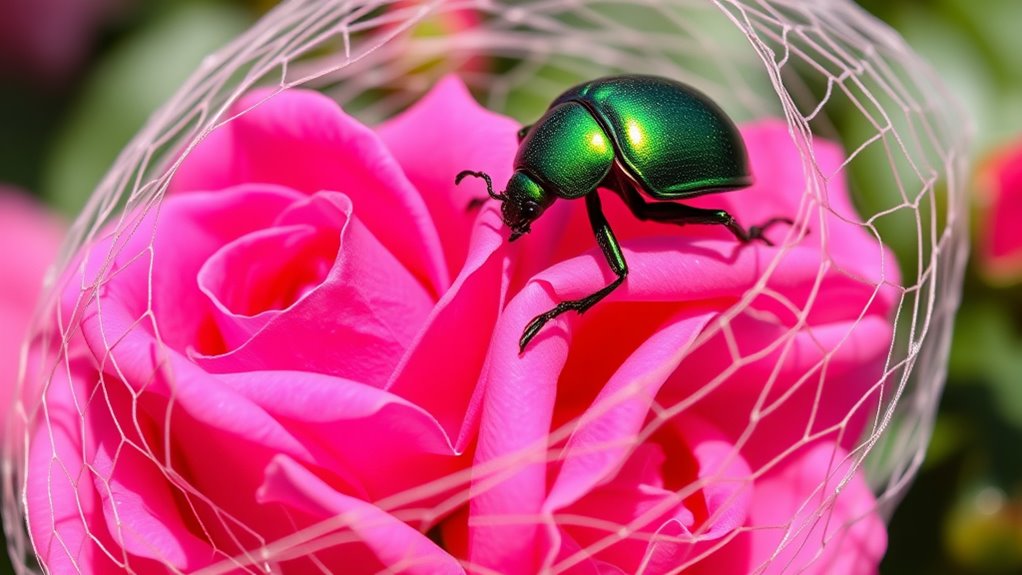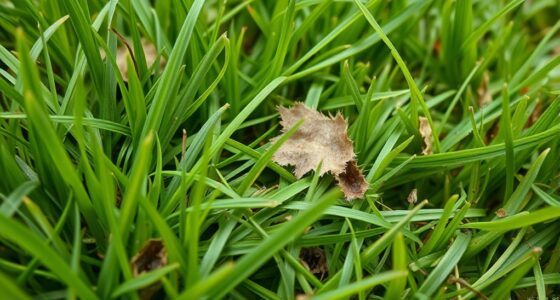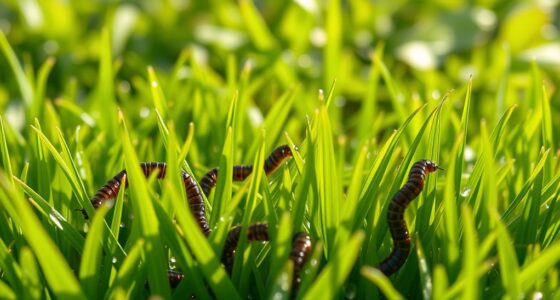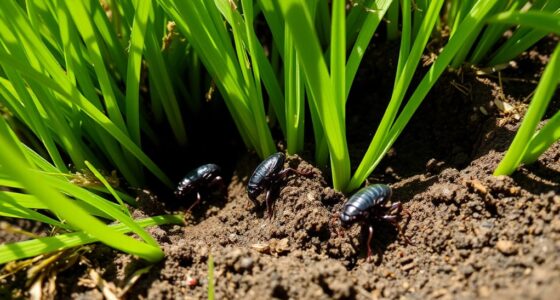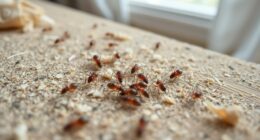To time protective netting against Japanese beetles on your roses, monitor their activity in mid to late summer when they become most active during warm, sunny days. Watch for early signs of feeding damage like jagged leaf edges or skeletonized leaves. Start netting as soon as you notice beetle emergence or signs of feeding to prevent significant damage. If you’re interested in detailed tips on choosing the right netting and maintaining protection, keep exploring these solutions.
Key Takeaways
- Begin netting when adult beetles emerge from soil and sightings increase in mid to late summer.
- Watch for early signs of feeding damage, such as ragged leaf edges and skeletonized foliage.
- Target netting during peak beetle activity late morning to early afternoon for maximum effectiveness.
- Use durable, UV-resistant netting that fits roses properly to prevent beetle entry.
- Combine netting with organic repellents and garden maintenance for comprehensive protection.
Understanding Japanese Beetle Behavior and Life Cycle
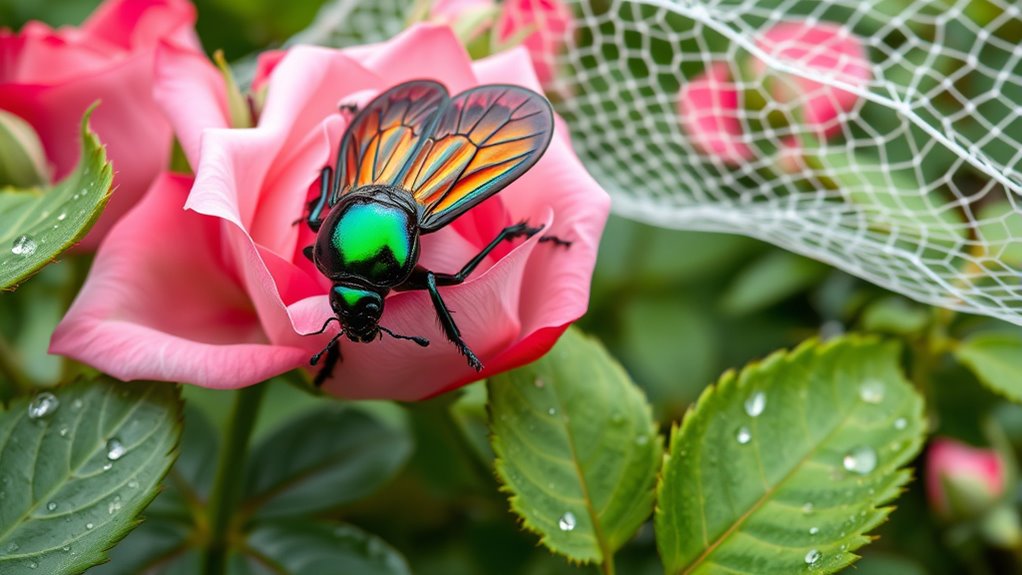
Understanding Japanese beetle behavior and their life cycle is essential for effectively managing infestations. You should know that their mating habits are quick and happen during warm days, typically in mid to late summer. Male beetles release pheromones to attract females, leading to active courtship. After mating, females lay eggs in the soil, usually in grassy areas. The beetle larva development begins underground, where grubs feed on roots, causing damage to plants. These larvae develop through several stages, or instars, over about a year before pupating. Knowing this cycle helps you time your control efforts, as adult beetles are most active during specific periods. Understanding these behaviors allows you to target vulnerable stages and reduce overall beetle populations effectively.
Identifying Peak Activity Periods for Japanese Beetles
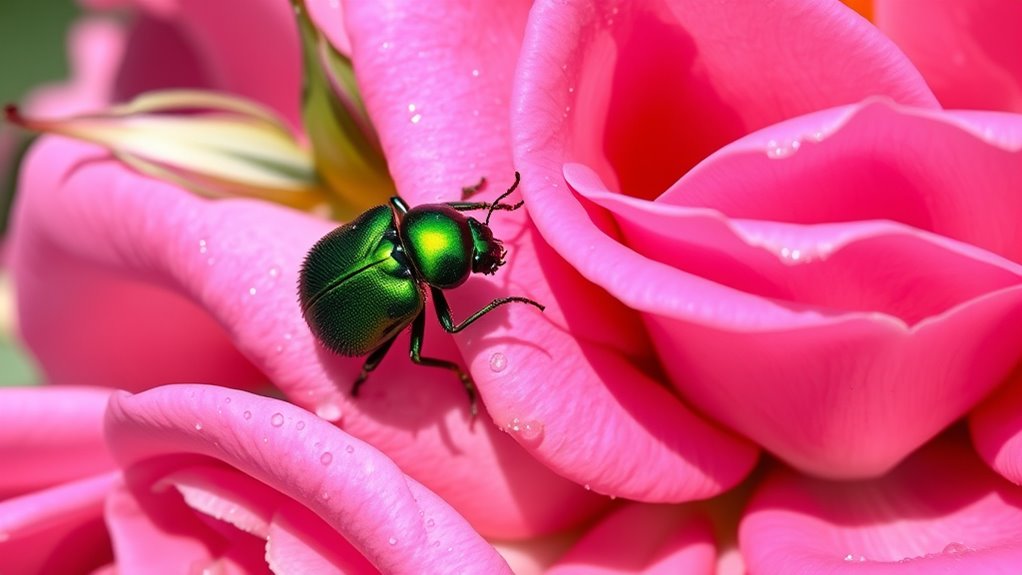
Japanese beetles are most active during warm, sunny days in mid to late summer, making this the critical period for monitoring and control. You’ll notice increased activity around dawn and dusk, especially as light diminishes, aligning with their dusk activity patterns. Peak mating behavior occurs in the late morning to early afternoon, but beetles are most vulnerable during dusk when they gather to feed and mate. Maintaining awareness of their peak activity periods can help optimize control efforts.
Recognizing Signs of Beetle Damage on Roses

You can spot beetle damage on roses by looking for specific patterns on the leaves. Chewing hole patterns and jagged leaf edges are common signs of feeding. Additionally, a skeletonized appearance of the leaves indicates significant beetle activity.
Chewing Hole Patterns
Chewing hole patterns are one of the clearest signs that Japanese beetles are feasting on your roses. You’ll notice irregular, ragged holes scattered across the petals and leaves, often concentrated around the flower color. These holes indicate beetle activity and can quickly damage the plant’s appearance. Pay attention to how the damage appears after rose pruning, as beetles tend to target freshly exposed tissues. The pattern of the holes can help you identify beetle feeding versus other pests. Look for clusters of small, evenly spaced holes, especially on the upper surfaces of petals. Recognizing these patterns early allows you to take prompt action, protecting your roses from further damage and maintaining their vibrant beauty. Pimple Patches can be effective for targeted treatment of blemishes caused by pests or other skin issues.
Chewing Leaf Edges
When beetles feed on your roses, they often leave jagged, uneven edges along the leaves’ margins. You’ll notice the torn appearance, with leaf edges appearing irregular and rough. Sometimes, the damage causes subtle color variations, such as brown or pale patches near the edges, indicating feeding activity. Japanese beetles tend to prefer certain parts of the plant, so you may see more pronounced damage on specific leaves or areas. Their feeding preferences result in a characteristic chewed look, making it easy to identify beetle activity. Keep an eye out for these uneven leaf margins, as they are a clear sign that your roses are under attack. Prompt detection helps you take timely action to protect your plants from further damage. Additionally, understanding the beetles’ feeding habits can help in selecting effective protective measures to safeguard your garden.
Skeletonized Leaf Appearance
Skeletonized leaves are a telltale sign of Japanese beetle activity on your roses. When you notice leaves in your flower bed with a lacy, skeleton-like appearance, it indicates these pests have been feeding heavily. The beetles chew away the tissue between veins, leaving only the veins intact, which exposes the leaf’s skeleton. This damage not only diminishes the plant’s beauty but also weakens its overall health. To protect your roses, early detection is key. Incorporate pest control methods such as handpicking beetles or applying appropriate insecticides. Using protective netting can also help prevent further damage. Regular inspection of your flower bed for skeletonized leaves ensures you catch beetle activity early and maintain healthy, vibrant roses. Additionally, understanding vacuum cleaner performance metrics can be useful for cleaning up debris or pests efficiently around your garden tools.
Optimal Timing for Deploying Protective Netting
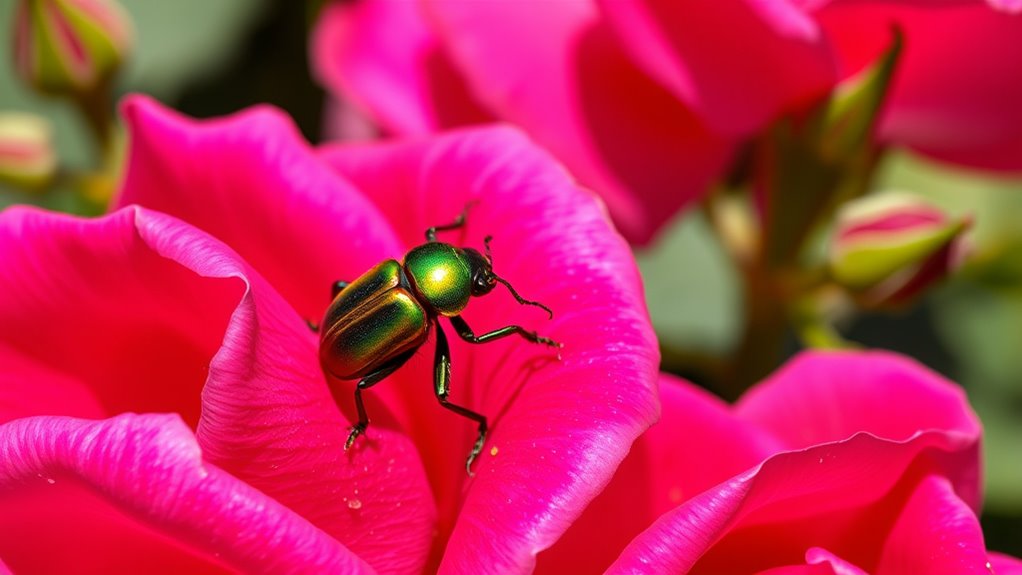
To effectively protect your ornamental roses from Japanese beetle damage, it’s crucial to deploy protective netting at the right time. Early intervention is key. You should monitor beetle activity closely and start netting when you notice:
- Adult beetles emerging from the soil
- Increased beetle sightings on nearby plants
- Signs of feeding damage on your roses
Using chemical repellents or encouraging natural predators can help reduce beetle populations before netting, but netting should be in place before feeding intensifies. Deploying netting too late allows beetles to cause significant damage. Timing your efforts ensures maximum protection and minimizes the need for chemical control. Stay vigilant and act promptly once beetle activity ramps up in your area. Additionally, understanding the timing of beetle emergence can help you anticipate and better prepare for peak feeding periods.
Selecting the Right Type of Netting for Your Roses

Choosing the right netting for your roses means considering material durability and breathability to keep pests out while allowing airflow. You’ll also want to pick a size and coverage option that fits your plants comfortably without obstructing growth. Ultimately, think about how easy it is to install and remove, so caring for your roses remains simple and hassle-free. Incorporating best beaches into your garden setup can provide a relaxing outdoor space that complements your plant protection efforts.
Material Durability and Breathability
When selecting netting to protect your ornamental roses, durability and breathability are key factors to contemplate. The netting material should withstand weather conditions without tearing or degrading quickly. Additionally, fabric breathability is essential to allow airflow, preventing excess moisture that can promote disease. Consider these points:
- Choose a netting material made from UV-resistant, tear-proof fibers for long-lasting protection.
- Opt for a fabric with high breathability to ensure proper air circulation around your roses.
- Avoid overly dense materials that restrict airflow, which can harm plant health and create a damp environment.
- Selecting a netting with material durability ensures it remains effective season after season, providing ongoing protection.
Balancing durability with fabric breathability ensures your roses stay protected from Japanese beetles without compromising their health.
Size and Coverage Options
Selecting the right size and coverage of netting is essential to effectively protect your roses from Japanese beetles. You need to choose a netting size that fits your plants without restricting growth or airflow. Smaller mesh sizes prevent beetles from squeezing through, while larger sizes may leave gaps. Coverage options vary, from individual plant covers to larger, row-wide nets. If you have a few roses, a compact, tailored netting piece works best. For broader protection, opt for larger covers that can shield multiple plants at once. Measure your roses carefully to ensure the netting provides complete coverage. Proper sizing prevents beetles from bypassing the netting while maintaining ease of access for watering and maintenance. Additionally, selecting a netting material with UV resistance can prolong its lifespan and effectiveness. The right coverage ensures your roses stay protected without unnecessary hassle.
Ease of Installation and Removal
Installing and removing netting should be quick and straightforward to minimize disruption to your roses. The right netting makes the installation ease seamless and the removal process simple. To choose the best option, consider:
- Material flexibility for easy draping or shaping around roses
- Lightweight design for quick setup and takedown
- Clear or fine mesh to prevent tangling and ease handling
- Durability ensures the netting withstands weather and repeated use over time.
These features help you avoid frustration and save time. Look for nets with sturdy edges or ties, which facilitate secure installation and easy removal. A well-designed netting system reduces stress during maintenance, so your roses stay protected without hassle. Ultimately, selecting netting that’s simple to install and remove keeps your gardening routine efficient and your roses well-protected.
Strategies for Maintaining and Monitoring Netting Effectiveness
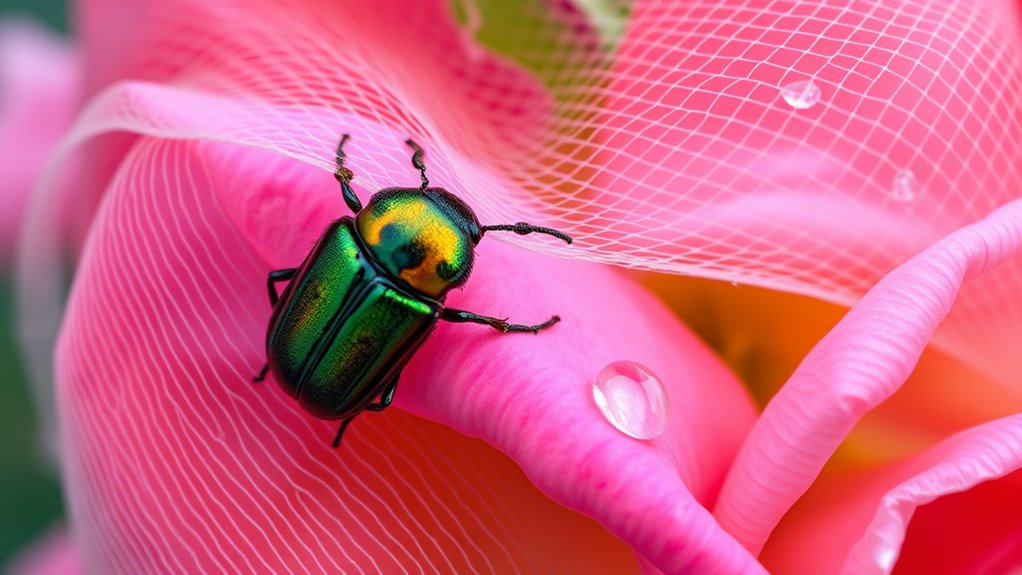
Regularly inspecting your netting is essential to guarantee it remains effective against Japanese beetles. During inspections, focus on pest identification to detect early signs of beetle activity or damage. Look for tears, holes, or areas where beetles may have slipped through. If you notice any damage, repair or replace the netting promptly to maintain its protective barrier. Monitoring also helps you assess the netting’s overall condition and effectiveness. Incorporate organic control methods by removing beetles trapped inside or on the netting, preventing reinfestation. Keep a routine schedule for checks, especially during peak beetle activity. Proper maintenance ensures your netting continues to shield your roses effectively, reducing the need for chemical interventions and supporting a healthy garden environment.
Additional Tips for Protecting Roses From Japanese Beetles
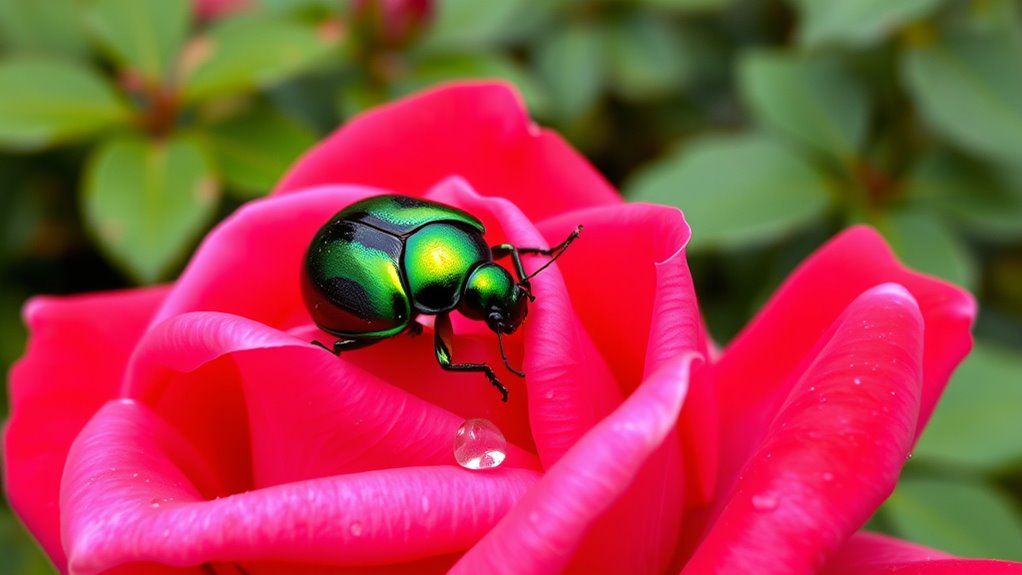
To further protect your roses from Japanese beetles, consider applying organic repellents such as neem oil or insecticidal soaps. These natural options can deter beetles without harming beneficial insects. Additionally, companion planting can be effective; plant garlic, chives, or catnip near your roses to repel beetles naturally. Here are some tips:
- Use organic repellents regularly, especially during peak beetle activity.
- Incorporate companion plants like garlic or chives around your roses for added protection.
- Keep the garden tidy by removing fallen leaves and debris that can harbor beetles.
- Monitoring your plants with air quality indicators can help identify and address pest issues early.
Combining organic repellents with strategic companion planting strengthens your defense and reduces beetle damage, keeping your roses healthy and vibrant.
Frequently Asked Questions
Can Japanese Beetles Harm Other Garden Plants Besides Roses?
Japanese beetles can harm more than just roses; they target a variety of beetle host plants. You should watch for their damage on garden plant vulnerability, including trees, shrubs, and other flowering plants. These pests feed on leaves, flowers, and fruits, so it’s essential to protect all susceptible plants. Using protective netting early can help prevent beetle damage across your entire garden, not just on roses.
How Do Weather Conditions Influence Japanese Beetle Activity?
Weather conditions act like a conductor guiding Japanese beetle activity. When temperature fluctuations rise, they signal beetles to emerge and feed, while cooler periods slow them down. Humidity levels also play a role, with high humidity encouraging movement and feeding, much like the rain awakening the earth. You’ll notice increased beetle activity during warm, humid days, so plan your protective measures accordingly to shield your garden from their damage.
Are There Natural Predators to Japanese Beetles in My Area?
You might wonder if natural predators can help control Japanese beetles in your area. Native predators, like certain birds, predatory beetles, and parasitic wasps, can naturally reduce beetle populations. Biological control methods leverage these predators to manage infestations sustainably. By encouraging or introducing these natural enemies, you support an eco-friendly approach to protect your roses without relying solely on chemical treatments.
How Long Should Netting Remain in Place to Protect Roses Effectively?
Think of netting like a shield that needs to stay in place just long enough to do its job. For effective protection, you should keep netting on your roses during the peak Japanese beetle activity, typically from late June to early August. The netting duration should align with this seasonal timing, usually 4 to 8 weeks, ensuring you block the beetles when they’re most active and prevent damage.
What Are Eco-Friendly Alternatives to Netting for Beetle Control?
You can try eco-friendly options like companion planting, which attracts beneficial insects that prey on beetles, reducing their numbers naturally. Organic sprays containing neem oil or insecticidal soap are also effective, providing a chemical-free way to deter beetles. These methods work well alongside timing protective netting, offering a sustainable approach to protect your roses without resorting to harmful chemicals or plastic barriers.
Conclusion
By understanding Japanese beetle behavior and timing your protective netting carefully, you can safeguard your roses effectively. But beware—those relentless beetles might find new ways to breach your defenses when you least expect it. Stay vigilant, monitor your netting regularly, and be ready to adapt your strategy. The battle isn’t over yet, and your roses’ beauty depends on your ability to outsmart these persistent pests before it’s too late.
